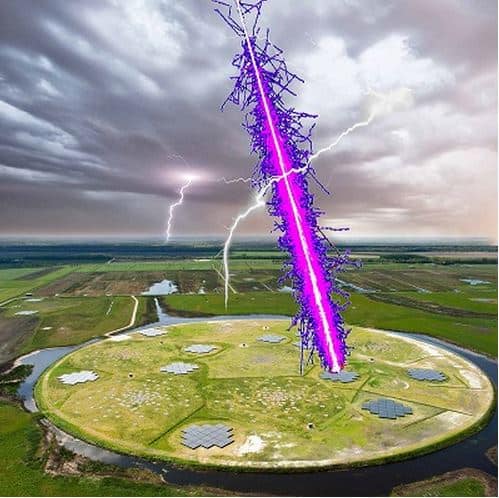Scientists say that by studying exploding stars we can better understand lightning and thunderclouds on Earth. The cosmic rays from the distant universe allow us to study thunderclouds and lightning in unprecedented detail, says an international team of researchers.
How is lightning triggered in thunderclouds? This is a difficult question to answer – how does one measure electric fields inside huge, dangerously-charged clouds?
A team of researchers wrote in the academic journal Physical Review Letters this week that they discovered more or less by coincidence that cosmic rays provide suitable probes to measure electric fields inside thunderclouds.

A particle shower initiated by a cosmic ray reaches LOFAR through a thundercloud. (Image: Radboud University)
The measurements were carried out with the LOFAR radio telescope located in the Netherlands.
Astronomer Pim Schellart, who completed his PhD in March 2015 at Radboud University in Nijmegen, the Netherlands, and is supervised by Prof. Heino Falcke, said:
“We used to throw away LOFAR measurements taken during thunderstorms. They were too messy. Well, we didn’t actually throw them away of course, we just didn’t analyze them.”
Schellart is interested in cosmic rays – high-energy particles that come from exploding stars and other astrophysical sources that continuously bombard our planet from space.
High up in our atmosphere, these particles strike atmospheric molecules, creating ‘showers’ of elementary particles.
It is possible to measure these showers from the radio emission that is generated when their constituent particles are deflected by Earth’s magnetic field.
The radio emission also provides data about the original particles. These measurements are routinely carried out with LOFAR at ASTRON (Netherlands Institute for Radio Astronomy) in Dwingelloo, but not during thunderstorms.
Modeling
All that changed when Schellart examined the data together with Gia Trinh and Prof. Olaf Scholten from the University of Groningen, and lightning expert Ute Ebe, who works at Centrum Wiskunde & Informatica in Amsterdam.
Schellart said:
“We modeled how the electric field in thunderstorms can explain the different measurements. This worked very well.”
“How the radio emission changes gives us a lot of information about the electric fields in thunderstorms. We could even determine the strength of the electric field at a certain height in the cloud.”
This field can be as strong as 50 kV/m (kilovolt/metre). This translates into a voltage of several hundred million volts over a distance of many kimometres – thunderclouds contain massive amounts of energy.
Dangerous charge
Lightning, a highly unpredictable natural phenomenon, kills and injures people, animals and plants and inflicts damage to infrastructure.
This new method for measuring electric fields within thunderclouds will help give us a better understanding and eventually improved predictions of lightning activity, the authors say.
Measurements currently obtained from small rockets, balloons or airplanes are dangerous and too localized. More importantly, the measuring equipment’s proximity to thunderclouds influences the measurements.
Cosmic rays probe the thunderclouds all the way through – from top to bottom. Moving at close to light speed they provide an almost instantaneous ‘picture’ of the electric fields within the cloud. Furthermore, they are naturally created and freely available.
Prof. Falcke said:
“This research is an exemplary form of interdisciplinary collaboration between astronomers, particle physicists and geophysicists. We hope to develop the model further to ultimately answer the question: how is lightning initiated within thunderclouds?”
Citation: “Probing atmospheric electric fields in thunderstorms through radio emission from cosmic-ray induced air showers,” Schellart et al. Physical Review Letters. Published April 24, 2015.

